|
|
|
Sort Order |
|
|
|
Items / Page
|
|
|
|
|
|
|
| Srl | Item |
| 1 |
ID:
104724
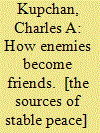

|
|
|
|
|
| Publication |
Princeton, Princeton University Press, 2010.
|
| Description |
xiii, 442p.
|
| Series |
Princeton studies in international history and politics
|
| Standard Number |
9780691142654, bhk
|
|
|
|
|
|
|
|
|
|
|
|
Copies: C:1/I:0,R:0,Q:0
Circulation
| Accession# | Call# | Current Location | Status | Policy | Location |
| 056037 | 303.66/KUP 056037 | Main | On Shelf | General | |
|
|
|
|
| 2 |
ID:
176983
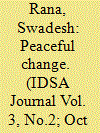

|
|
|
| 3 |
ID:
060298
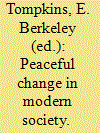

|
|
|
|
|
| Publication |
California, Hoover Institution Publication, 1971.
|
| Description |
ix, 158 p.hbk
|
| Series |
Hoover Institutions Publication;101
|
|
|
|
|
|
|
|
|
|
|
|
Copies: C:1/I:0,R:0,Q:0
Circulation
| Accession# | Call# | Current Location | Status | Policy | Location |
| 009027 | 303.4/TOM 009027 | Main | On Shelf | General | |
|
|
|
|
| 4 |
ID:
160062
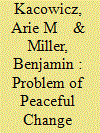

|
|
|
|
|
| Summary/Abstract |
In this paper, we examine the perennial problem of peaceful change (how to bring about a change in the status quo by means other than war?) by reflecting on the post-Cold War order from 1991 to 2017. We examine the problem at three different levels of analysis: systemic (great power interactions), interactive (peaceful territorial change), and domestic (democratization efforts). At the interactive level, we assess the record of successes and failures of peaceful territorial changes since 1991 to the present. At the systemic level, we assess the inherent difficulties embedded in systemic peaceful change (the decline of the US hegemony, the rise of China, the revival of Russia?). At the domestic level, we focus upon democratization efforts. In this context, we particularly emphasize the contours of the emerging illiberal international order in keeping peace and the status quo, bringing war, or facilitating the possibility of peaceful change. Finally, we suggest possible links between domestic, interactive, and systemic peaceful change, and suggest an agenda for future research.
|
|
|
|
|
|
|
|
|
|
|
|
|
|
|
|
| 5 |
ID:
187397
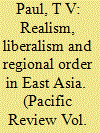

|
|
|
|
|
| Summary/Abstract |
East Asia offers a fertile ground for applying dominant theoretical perspectives in International Relations and understanding their relevance and limitations. As this region has seen much conflict and cooperation historically and is re-emerging as a key theater of great power competition in the 21st century even when states maintain high levels of economic interactions, our understanding of the regional order will be enhanced by the theoretical tools available in the larger mainstream IR perspectives. The existence of a peculiar regional order of no war, yet a number of simmering disputes (along with high levels of economic interdependence) can be characterized as cold peace which deserves an explanation. The paper applies two variants of realism—balance of power and hegemonic stability – and the key arguments in liberalism to analyze the cold peace in Northeast Asia and normal peace in Southeast Asia from a historical perspective. It finds both grand theoretical approaches have partial applications for understanding the East Asian order. A hybrid approach is more valuable to better explain regional order during diverse time periods and different sub-regions of East Asia. Although the presence of both hegemony and balance of power can prevent major wars for a period, they do not help resolve the pre-existing disputes. Deepened economic interdependence mitigates some spiraling tendencies as states fearful of losing too much economically do not escalate crises beyond a point.
|
|
|
|
|
|
|
|
|
|
|
|
|
|
|
|
| 6 |
ID:
153905
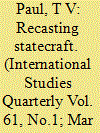

|
|
|
|
|
| Summary/Abstract |
Much of mainstream International Relations (IR) scholarship considers war to be a precondition for significant changes at the systemic level. Peaceful change as a subject has received limited attention in Realism, except by E. H. Carr and Robert Gilpin, although several strategies for stability are present in the paradigm. Mechanisms inherent in Liberalism have offered the most insights on obtaining change without war. Constructivism also focuses on change, caused largely by norms and inter-subjective ideational forces. Yet concrete strategies for peaceful change at the international level remain elusive in much of IR theory. The traditional grand strategy literature has focused most attention on obtaining national objectives through war while ignoring peaceful mechanisms of change and transformation. This article, based on my presidential address at the 57th ISA Convention in Atlanta in March 2016, calls for a reorientation in the grand strategy literature by incorporating strategies of peaceful change. It examines the contributions for peaceful change made by Europe, the United States, and rising and resurgent powers Russia, China, India, Brazil, and South Africa, in addition to ASEAN as a regional grouping. The article concludes by asking why some of these countries pursued peaceful strategies of change at various points in time only to abandon them subsequently. The article calls on the IR discipline to think more clearly about strategies for peaceful change and foreign policymakers to adapt and reorient succeeding generations to seek change without violence as a subject matter of serious study.
|
|
|
|
|
|
|
|
|
|
|
|
|
|
|
|
| 7 |
ID:
187395
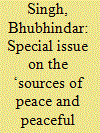

|
|
|
|
|
| Summary/Abstract |
East Asia is usually associated with war and conflict. This applies to its historical past, as well as to the present post-Cold War period. In fact, this pessimism on the region has hardened with the worsening structural US-China competition since 2010. Challenging this prevailing view, this special issue argues that the concepts of peace and peaceful change are critical elements to explain East Asian regional dynamics in the post-Cold War period. It poses the following questions: (a) how could peace and peaceful change be analysed conceptually at the regional level?; (b) what type of peace and peaceful change notions are applicable to East Asia?; (c) what are the sources and mechanisms of regional peace in East Asia and its sub-regions and how have the sources and mechanisms changed over the post-Cold War period?; (d) how has the worsening US-China structural competition affected the prospects of peace in East Asia?; and (e) how do the middle powers, namely Japan, South Korea, Australia and Indonesia, contribute to peace and peaceful change in the region? The special issue is the first attempt to systematically apply the concepts of peace and peaceful change on East Asia. The articles identify the sources and mechanisms of peace and peaceful change, apply an eclectic conceptual approach that combines traditional and non-traditional IR theories; and assess the prospects of peace in East Asia in the context of the worsening structural tensions presented by the US-China competition.
|
|
|
|
|
|
|
|
|
|
|
|
|
|
|
|
|
|
|
|
|